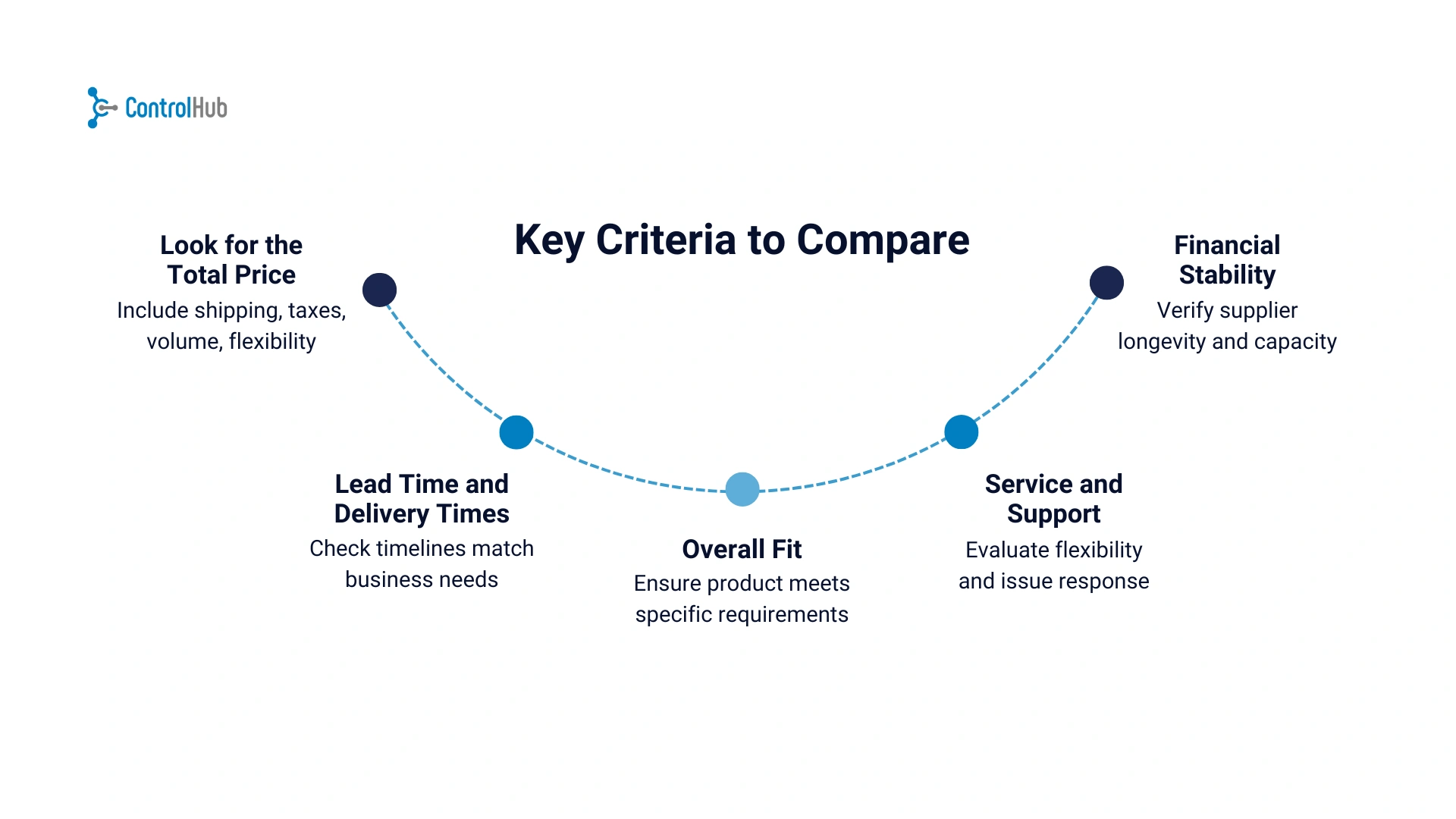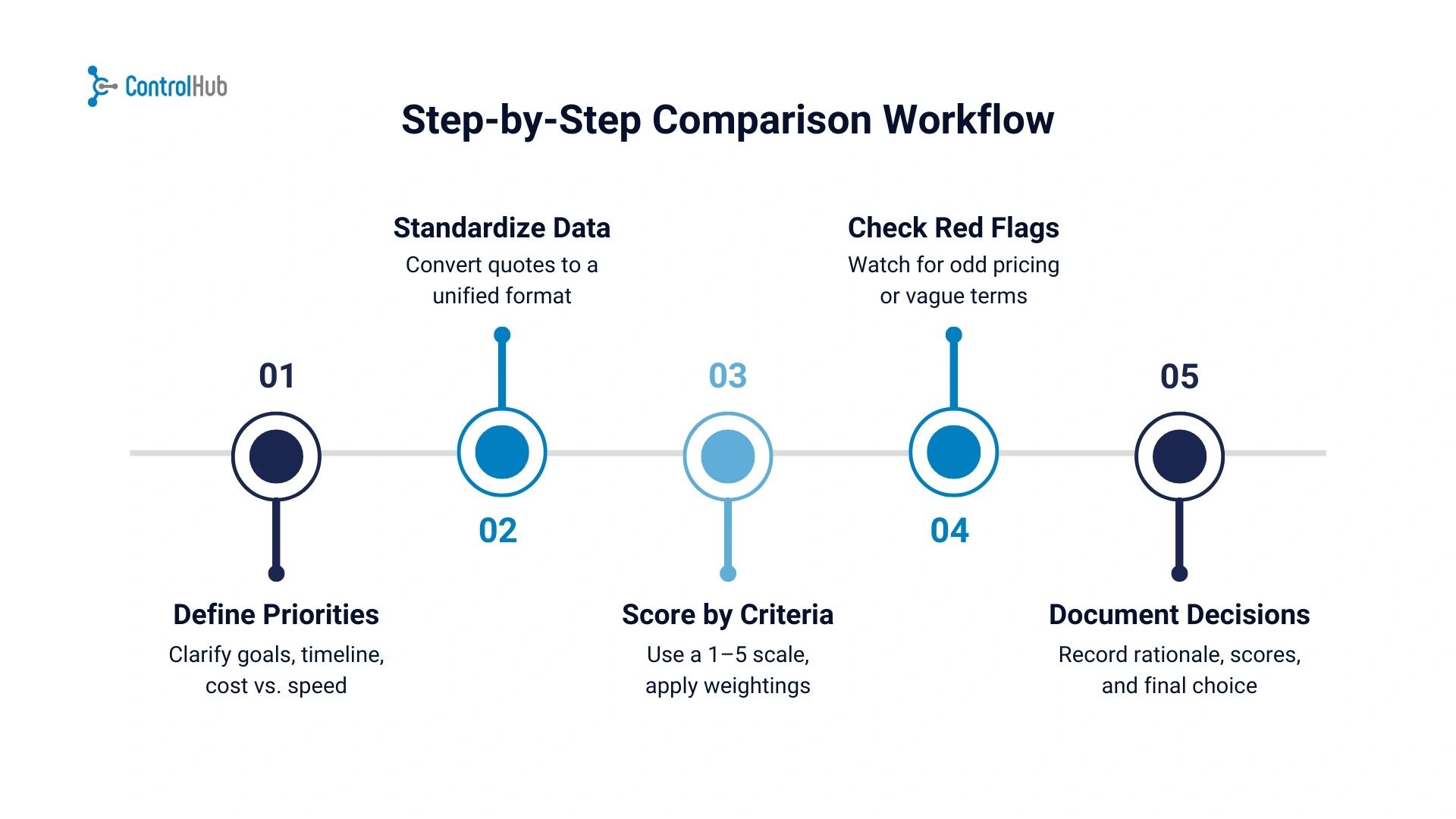Free Supplier Risk Scorecard Download
Download our free supplier risk scorecard here!
Download the free tool!AI Summarize:
It should be simple
You consider purchasing something for your business, search for suppliers, get the quotations, and voila, you are ready to make the best decision based on a single factor like pricing.
Everything comes down to money, right?
Well, not really
And no, making a decision isn't as straightforward as that.
First?
You've to determine whether Supplier A, B, or C is giving you the best value in their quotations.
And that is not always easy.
Why Should You Have a Process for Quotation Comparison?
Believe it or not, it might be tempting to skip the part of sitting down and having to deal with multiple quotes from potential suppliers. You look over a couple of options, find the cheapest, and call the day off.
And…that's where problems begin.
Missed savings, confused expectations, or worse, you sign a deal with a supplier that's not even slightly aligned with your business.
Problem after problem
Working under a structure to compare supplier quotations gives you full picture visibility so you can look beyond the material side of things, i,e: price.
For example, it's simpler to focus on:
- What's the delivery timeline?
- Are additional services included?
- What are the payment terms?
- Hidden fees?
Beyond the numbers, there’s also a strategic upside. When you standardize how you review quotes, it becomes easier to spot outliers, benchmark suppliers against one another, and negotiate from a position of real clarity.
Things that are fundamental for better supplier relationships and more cost-effective procurement.
Key Criteria to Compare
As we said in the intro, focusing solely on the price is a direct pathway for messy and negative results, and while it's true that not all quotations are going to follow the same format, there are certain aspects you need to always consider
Look for the total price.
No, we don't mean just the headline numbers.
Sure, you need to know what the unit cost is and if there are any discounts for volume.
But that's only the basics
Are shipping fees included? Taxes?
Can you buy as little or as much as you need?
Not to be pessimistic, but sometimes what you see as cheap can become one of the most expensive things in the long term.
Lead time and delivery times
This is one of the most important deal breakers.
When searching for supplier alternatives, look beyond price tags and ask questions like:
- How soon will the product arrive at your location?
- Are both timeless (suppliers' and businesses’) aligned?
Late deliveries can seriously deteriorate your operations.
Overall fit
You are purchasing something because you need it, after all.
A great price won’t matter if the product doesn’t meet your requirements.
Look for certifications, product samples, references, or even past performance data.
Does the supplier understand your use case? Are they offering the right materials, tolerances, or tech requirements?
Service and support
Your relationship with suppliers doesn't end when the products are delivered.
What happens if something goes wrong and you need urgent support? Maybe you need to purchase in higher volumes unexpectedly. Are they ready to be flexible?
Financial stability
This one might not explicitly come as part of a quotation, but it's definitely something you must look at before making a decision. Check the financial health of the supplier, their production capacity, and how long they’ve been in business. The last thing you want is a supplier that disappears halfway through a contract or can’t keep up with growing demand.
Free Supplier Risk Scorecard Download
Download our free supplier risk scorecard here!
Download the free tool!Tools You Can Use for Quotation Comparison
Start with a comparison table
Things shouldn't always be complicated to begin with.
If you want to determine which supplier is giving you the best terms, there's nothing wrong with starting with an old-fashioned comparison table.
List down your main criteria, like price, lead time, quality indicators, and payment terms, then fill in the details row by row for each supplier.
You can use a simple spreadsheet for this purpose, or if you are more of a visual person, use Canva.
Use weighted scoring models
Yes, the criteria are important
But not all criteria weigh the same. For example, if you are looking for a quick contract, there's not much sense in choosing someone who only offers, let's say, early payment discounts after one year of partnership. On the other side of the story, a 2-day lead time might not add much to the relationship, depending on your requirements.
Weighted scoring helps you assign importance to each factor, then gives you a composite score for each supplier. It’s especially helpful when the choice isn’t straightforward.
Automate, of course
We couldn't let this one pass.
Because, yeah…automating things can change the outcome of your comparison for the better. If you are constantly receiving quotations with multiple details and your team starts struggling to handle so much information, it might be time to work with a digital solution.
There are platforms out in the market, precisely designed to pull data from multiple sources and highlight variances.
These systems are especially useful if you’re working across departments or regions and need a consistent comparison method.
Standardize RFQs
Do you want to have a structured comparison process?
Start with having a standard RFQ. Create a model that makes sense for your expectations and business.
Free Supplier Risk Scorecard Download
Download our free supplier risk scorecard here!
Download the free tool!Step-by-Step Comparison Workflow
Okay, so you got the quotations, now what?
How can you know you are looking at the right factors or following all the necessary steps?
Define what you're optimizing for
Start by outlining the reasons you are interested in making this purchase.
What's the justification? What are you expecting to cover? For when?
If you had to choose between speed and costs, which option would have the most impact on your operations?
Be as clear as possible with your company's priorities so it's simpler to filter and rank suppliers later.
Standardize your data
Remember, RFQs should also be under the same format. Quotes often come in all shapes and formats, one in a polished Excel file, another in a rough email. the more you get, the harder it is to know what you are really looking for.
Bring them into a single comparison format so you’re not wasting time decoding each one.
Score based on key criteria
Time to work
Once you've collected and organized all the information from the suppliers, it's time to assign scores to each supplier based on the criteria that matter most to your project. Use a consistent scale, for example, 1 to 5, and apply any weightings you decided on.
Check for red flags
Just like you'd do in any other relationship, right?
Well, yes.
Take a minute to look at the quotation from an objective point of view.
Does something look off?
Any unusually low or high prices? Unclear terms? Missing information? Make sure to really check anything that doesn’t feel real.
Sometimes, a very good quote turns out to be too good to be true, so a bit of precaution won't hurt anyone.
Document everything
Once you’ve made a decision, keep a record of why.
What were the deciding factors? How did the scoring shake out? Having a clear audit trail helps defend your decision later and can serve as a benchmark when you revisit the supplier or go through a similar process next time.
The Lesson
If you’ve ever felt like comparing supplier quotes takes way more time than it should, you’re not alone.
It’s one of those things that sounds simple until you’re feeling lost looking at five different formats, half-answered questions, and numbers that don’t line up.
That’s exactly why having a consistent way to approach it makes a difference. Not just for speed, but for peace of mind. It doesn’t have to be fancy. A clean layout, clear priorities, and a few checks along the way go a long way. And once you’ve got your process in place, you’ll start noticing it gets easier. Faster. And a lot less stressful.
Free Supplier Risk Scorecard Download
Download our free supplier risk scorecard here!
Download the free tool!Free Supplier Risk Scorecard Download
Download our free supplier risk scorecard here!
Download the free tool!Key Takeaways
- A structured comparison process saves time and stress.
Jumping between quotes without a system leads to delays and bad calls. Standardizing your approach upfront makes everything easier. - Price is just one piece of the puzzle.
Always consider lead times, service terms, quality, and supplier reliability alongside cost. - Scoring models help you stay objective.
Especially when the choice isn’t obvious — a simple weighted system can keep things fair and transparent. - Use tools that work for your team.
Whether it's a spreadsheet, a template, or an automated platform, pick a method that fits your workflow (and doesn’t slow you down). - Red flags matter.
Watch out for vague terms, too-good-to-be-true prices, and inconsistent details. These usually signal future problems. - Document your decision-making.
Keeping track of how you made your choice makes future reviews and negotiations way easier — and builds internal trust.
%20(1).avif)

















.png)


